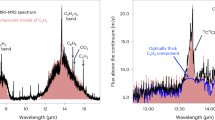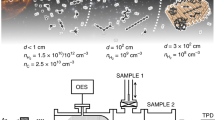Abstract
The 2,200 Å hump in the interstellar extinction curve has attracted much attention since its discovery by Stecher1. Graphitic2,3 and carbonaceous grains4 and MgO (ref. 5) have been considered as possible candidates. Sakata et al.4 have reported a hump near 2,200 Å in the absorption spectrum of an extract from the Murchison meteorite, a C2 carbonaceous chondrite. The hump was presumed to be due to hydrocarbons having conjugated double bonds. It is highly probable that the interstellar extinction is caused by carbonaceous materials containing such conjugated double bonds. In the present experiment, carbonaceous materials were synthesized by injecting a plasmic gas mixture of hydrogen and carbon into a vacuum chamber. Extinction of the material was measured over the range 1,900–7,000 Å. The extinction profile of the synthesized material clearly exhibits the 2,200 Å hump, the average value for the central wavelength being 2,170±30Å.
This is a preview of subscription content, access via your institution
Access options
Subscribe to this journal
Receive 51 print issues and online access
$199.00 per year
only $3.90 per issue
Buy this article
- Purchase on Springer Link
- Instant access to full article PDF
Prices may be subject to local taxes which are calculated during checkout
Similar content being viewed by others
References
Stecher, T. P. Astrophys. J. 142, 1683–1684 (1965).
Stecher, T. P. & Donn, B. Astrophys. J. 142, 1681–1683 (1965).
Wickramasinghe, N. C. & Guillaume, C. Nature 207, 366–368 (1965).
Sakata, A. et al. Nature 266, 241 (1977).
MacLean, S. & Duley, W. W. Astrophys. J. Lett. 256, L61–L64 (1982).
Sakata, A. IAU Symp. No 87 325–329 (1980).
Savage, B. D. & Mathis, J. S. A. Rev. Astrophys. 17, 73–111 (1979).
Nandy, K., Thompson, G. I., Jamar, C., Monfils, A. & Wilson, R. Astr. Astrophys. 44, 195–203 (1975).
Savage, B. D. Astrophys. J. 199, 92–109 (1975).
Mendoza, V. E. E. & Johnson, H. L. Astrophys. J. 141, 161–169 (1965).
Author information
Authors and Affiliations
Rights and permissions
About this article
Cite this article
Sakata, A., Wada, S., Okutsu, Y. et al. Does a 2,200 Å hump observed in an artificial carbonaceous composite account for UV interstellar extinction?. Nature 301, 493–494 (1983). https://doi.org/10.1038/301493a0
Received:
Accepted:
Issue Date:
DOI: https://doi.org/10.1038/301493a0
This article is cited by
-
The mystery of unidentified infrared emission bands
Astrophysics and Space Science (2022)
-
Organic matter in space: from star dust to the Solar System
Astrophysics and Space Science (2009)
-
Some theoretical considerations about the origin of the 220 nm interstellar hump
Astrophysics and Space Science (1996)
Comments
By submitting a comment you agree to abide by our Terms and Community Guidelines. If you find something abusive or that does not comply with our terms or guidelines please flag it as inappropriate.



